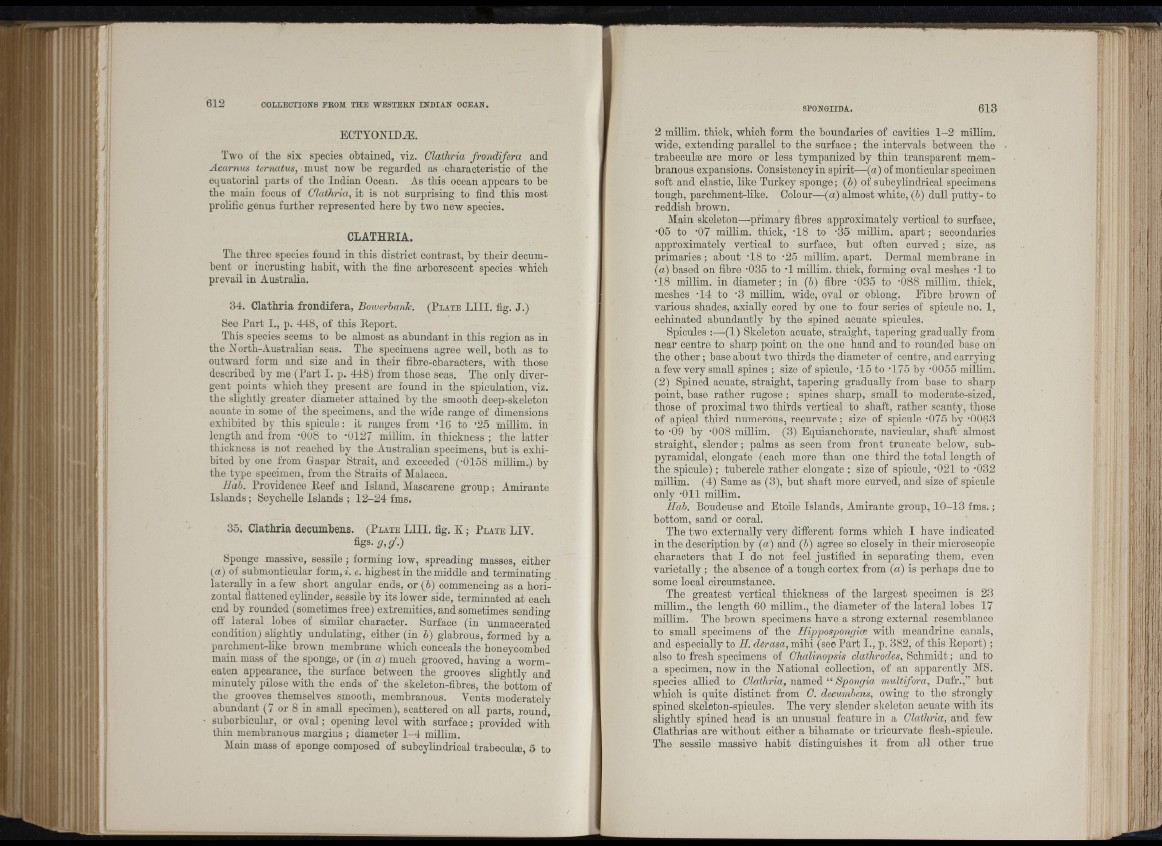
ECTYONIDA.
Two of the six species obtained, viz. Clathria frondifera and
Acarnus ternatus, must now be regarded as characteristic of tbe
equatorial parts of the Indian Ocean. As tbis ocean appears to be
tbe maiu focus of Clathria, it is not surprising to find tbis most
prolific genus further represented here by two new species.
in
CLATHRIA.
Tbe three species found in this district contrast, by tbeir decumbent
or incrusting habit, witb tbe fine arborescent species which
prevail in Austraha.
34. Clathria frondifera, Boiverhank. ( P l a t e L III. fig. J.)
¡See P a rt I., p. 448, of tbis Report.
This species seems to be almost as abundant in tbis region as in
tbe North-Australian seas. Tbe specimens agree well, botb as to
outward form and size and in their fibre-cbaracters, witb those
described by me (Part I. p. 448) from those seas. Tbe only divergent
points wbicb tbey present are found in tbe spiculation, viz.
tbe slightly greater diameter attained by tbe smooth deep-skeleton
acuate in some of the specimens, and the wide range of dimensions
exhibited by tbis spicule : it ranges from -16 to -25 millim. in
leugtb and from -0U8 to -0127 millim. in thickness ; the latter
thickness is not reached by tbe Australian specimens, but is exhibited
by one from Gaspar Strait, and exceeded (-0158 millim.) by
tbe type specimen, from tbe Straits of Malacca.
Bab. Providence Peef and Island, Mascarene group; Amirante
Islan d s; SeycbeUe Islands ; 12-24 fms.
?■' z iii
■ a Í
35. Clathria decumbens. ( P l a t e L III. fig. K ; P l a t e LIV.
g,g'.)
Sponge massive, sessUe ; forming low, spreading masses, either
(a) of submonticular form,L e. highest in tbe middle and terminating
lateraPy in a few short angular ends, or (5) commencing as a horizontal
flattened cyUnder, sessile by its lower side, terminated at each
end by rounded (sometimes free) extremities, and sometimes sending
off lateral lobes of similar character. Surface (in nnmacerated
condition) shghtly undulating, either (in b) glabrous, formed by a
parcbment-bke brown membrane which conceals tbe honeycombed
main mass of tbe sponge, or (in a) mucb grooved, having a worm-
eaten appearance, tbe surface between tbe grooves slightly and
minutely pilose witb tbe ends of the skeleton-fibres, tbe bottom of
tbe grooves themselves smooth, membranous. Vents moderately
abundant (7 or 8 in smaU specimen), scattered on all parts, round,
suborbicular, or oval ; opening level witb surface ; provided with
thin membranous margius ; diameter 1-4 millim
Main mass of sponge composed of subcylindrical trabeeulæ, 5 to
! I i: ñ , :
2 mUlim. thick, which form tbo boundaries of cavities 1 -2 millim.
wide, extending parallel to the surface ; tbe intervals between tbe
trabeeulæ are more or less tympanized by thin transparent membranous
expansions. Consistency in spirit—(a) of monticular specimen
soft and elastic, like Turkey sponge; (6) of subcylindrical specimens
tough, parchment-like. Colour—(a) almost white, (6) dull putty- to
reddish brown.
Main skeleton—primary fibres approximately vertical to surface,
•05 to ^07 millim. thick, -18 to -35 millim. ap art; secondaries
approximately vertical to surface, bnt often curved; size, as
primaries ; about '18 to -25 millim. apart. Dermal membrane in
(a) based on fibre -035 to -1 millim. thick, forming oval meshes -1 to
•18 millim. in diameter; in (b) fibre ‘035 to *088 millim. thick,
meshes '14 to ’3 millim. wide, oval or oblong. Eibre brown of
various shades, axiaUy cored by one to four series of spicule no. 1,
echinated abundantly by tbe spined acuate spicules.
SpiciPes :—(1) Skeleton acuate, straight, tapering graduaUy from
near centre to sbarp point on tbe one hand and to rounded base on
tbe o tb e r; base about two thirds tbe diameter of centre, and carrying
a few very smaU spines ; size of spicule, '15 to -175 by -0055 millim.
(2) Spined acuate, straight, tapering gradually from base to sharp
point, base ratber rugose; spines sbarp, small to moderate-sized,
those of proximal two thirds vertical to shaft, rather scanty, those
of apical tbird numerous, recúrvate; size of spicule -075 by -0063
to -09 by -008 millim. (3) Equianchorate, navicular, sbaft almost
straight, slender; palms as seen from front truncate below, snb-
pyramidal, elongate (each more than one third the total length of
the spicule) ; tubercle rather elongate ; size of spicule, -021 to -032
millim. (4) Same as (3), but shaft more curved, and size of spicule
only 'O il millim.
Hab. Boudeuse and Etoile Islands, Amirante group, 10-13 fms.;
bottom, sand or coral.
The two externally very different forms which I have indicated
in the description by (a) and (b) agree so closely in their microscopic
characters tb a t I do not feel justified in separating them, even
varietally ; tbe absence of a tough cortex from (a) is perhaps due to
some local circumstance.
Tbe greatest vertical thickness of the largest specimen is 23
millim., tbe length 60 millim., tbe diameter of tbe lateral lobes 17
miUim. Tbe brown specimens have a strong external resemblance
to small specimens of the Hippospongioe with meandrine canals,
and especially to H. derasa, mibi Qee P art I., p. 382, of this Peport) ;
also to frosb specimens of Chalinopsis clathrodes, Schmidt; and to
a specimen, now in tbo National collection, of an apparently MS.
species allied to Clathria, named “ Spongia multifora, Dufr.,” but
wbicb is quite distinct from C. decumbens, owing to tbe strongly
spined skeleton-spicules. The very slender skeleton acuate witb its
slightly spined bead is an unusual feature in a Clathria, and few
Clatbrias are without either a bihamate or tricurvate flesh-spicule.
The sessile massive habit distinguishes it from all otber true
;